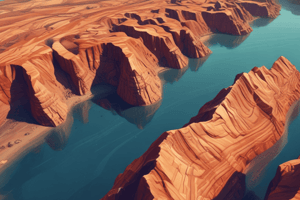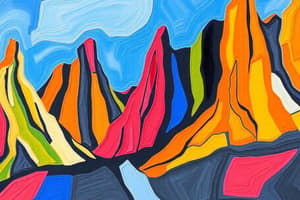Podcast
Questions and Answers
If the rate of ablation exceeds the rate of accumulation in a glacier, what is the most likely consequence?
If the rate of ablation exceeds the rate of accumulation in a glacier, what is the most likely consequence?
- The glacier's thickness will increase due to increased snowfall.
- The glacier will retreat, decreasing in size. (correct)
- The glacier will advance, increasing in size.
- The glacier's equilibrium line will remain stable.
Which of the following processes is most directly responsible for the creation of drumlins?
Which of the following processes is most directly responsible for the creation of drumlins?
- Tectonic plate collisions.
- Volcanic activity.
- Glacial deposition under an ice sheet. (correct)
- Erosion by fast-flowing rivers.
Which factor related to 'LOWERN' explains why coastal regions generally have milder temperatures than inland areas at the same latitude?
Which factor related to 'LOWERN' explains why coastal regions generally have milder temperatures than inland areas at the same latitude?
- Wind
- Latitude
- Ocean currents (correct)
- Relief
What type of rock is formed from the cooling and solidification of magma or lava?
What type of rock is formed from the cooling and solidification of magma or lava?
If a location experiences prevailing winds carrying moist air that is forced to rise over a mountain range, what precipitation pattern is most likely to occur?
If a location experiences prevailing winds carrying moist air that is forced to rise over a mountain range, what precipitation pattern is most likely to occur?
Which of the following landform features provides the strongest evidence of past glacial activity?
Which of the following landform features provides the strongest evidence of past glacial activity?
In the rock cycle, what process is most directly responsible for transforming sedimentary rock into metamorphic rock?
In the rock cycle, what process is most directly responsible for transforming sedimentary rock into metamorphic rock?
Which of the following statements best describes the relationship between tectonic plates and earthquakes?
Which of the following statements best describes the relationship between tectonic plates and earthquakes?
What is the key difference between continental glaciation and alpine glaciation?
What is the key difference between continental glaciation and alpine glaciation?
What is the most accurate definition of 'growing season' in the context of climate and agriculture?
What is the most accurate definition of 'growing season' in the context of climate and agriculture?
Flashcards
Tectonic Plate
Tectonic Plate
Massive, irregularly shaped slab of solid rock, generally composed of both continental and oceanic lithosphere.
Weathering
Weathering
The process where rocks are gradually worn away by natural agents.
Erosion
Erosion
The geological process in which earthen materials are worn away and transported by natural forces.
Pangea
Pangea
Signup and view all the flashcards
Climate Graph
Climate Graph
Signup and view all the flashcards
LOWERN
LOWERN
Signup and view all the flashcards
Relief Precipitation
Relief Precipitation
Signup and view all the flashcards
Growing Season
Growing Season
Signup and view all the flashcards
Alpine Glacier
Alpine Glacier
Signup and view all the flashcards
Till
Till
Signup and view all the flashcards
Study Notes
- Landforms are natural features of the Earth's surface.
Tectonic Plates and Earthquakes
- Tectonic plates are sections of the Earth's crust that move and interact, causing earthquakes.
- Convection currents in the Earth's mantle drive the movement of tectonic plates.
Pangaea
- Pangaea was a supercontinent that existed millions of years ago, before breaking up into the continents we know today.
Weathering and Erosion
- Weathering is the breakdown of rocks and minerals on the Earth's surface.
- Erosion is the process by which weathered material is transported away.
Landform Creation
- Landforms are created through a combination of tectonic activity, weathering, and erosion.
Canadian Landform Regions
- Canada has 7 distinct landform regions.
Unique Landform Features
- Unique landform features are distinctive geological formations.
Rock Cycle
- The rock cycle is a continuous process in which rocks are formed, broken down, and reformed.
Types of Rocks
- The three main types of rocks are igneous, sedimentary, and metamorphic.
Factors Affecting Climate: LOWERN
- Latitude, Ocean currents, Wind, Elevation, Relief, Near water affect climate.
Relief Precipitation
- Relief precipitation occurs when air is forced to rise over mountains, causing it to cool and condense, resulting in precipitation.
Climate Graphs
- Climate graphs visually represent temperature and precipitation patterns for a specific location.
Growing Season
- The growing season is calculated by determining the number of days between the last frost in spring and the first frost in fall.
Glaciation
- Glaciation is the process by which glaciers form and move.
- Continental glaciers are large ice sheets that cover vast areas of land.
- Alpine glaciers are glaciers that form in mountainous regions.
Glacial Deposits
- Drumlins are elongated hills formed by glacial ice.
- Erratics are large rocks transported by glaciers and deposited in a different location.
- Till is unsorted sediment deposited by glaciers.
- Striations are scratches on rocks caused by glacial movement.
Glacial Terms
- Ablation is the loss of ice and snow from a glacier.
- A crevasse is a deep crack in a glacier.
- Accumulation is the build-up of ice and snow on a glacier.
- Equilibrium is the state of balance between accumulation and ablation on a glacier.
Studying That Suits You
Use AI to generate personalized quizzes and flashcards to suit your learning preferences.
Description
Explore landforms, tectonic plates, earthquakes, and Pangaea. Learn about weathering, erosion, and the rock cycle. Discover Canada's unique landform regions and geological formations.




